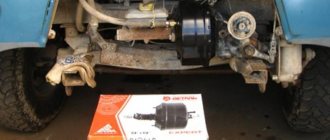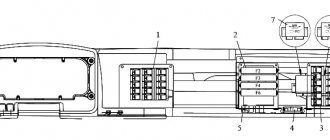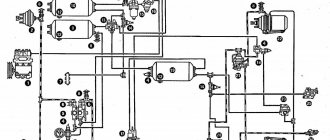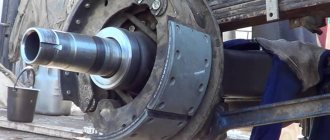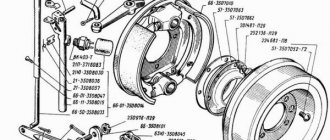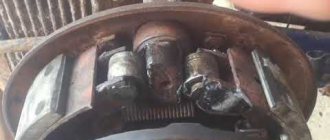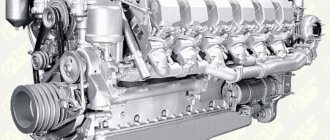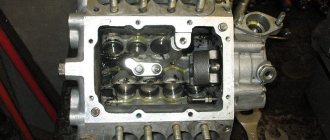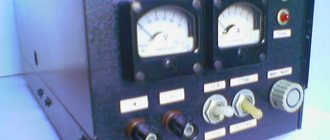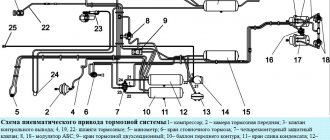About the areas of application and modifications of the GAZ-53
On its not particularly powerful shoulders, the GAZ-53 nevertheless “rolled” at least half of the entire economy of the Country of Soviets. It's hard to find where this ubiquitous truck has NOT been used. From the “gait” for emergency crews and the “paddy wagon” for criminals to mobile fuel tankers and truck tractors that hauled containers - everything that was not installed on the GAZ-53 chassis!
These cheap, simple and unpretentious trucks have become widespread in agriculture. In the 70s/early 80s of the 20th century, on the average Soviet collective farm, 80% of the truck fleet consisted of GAZ-53. Only in the second half of the 80s did this ratio begin to change towards an increase in the share of ZIL-130, which, by the way, in Soviet times did not cost much more than GAZon.
GAZ-53 of the 60s and 80s both look noticeably different from each other, and in a technological sense these are two quite different trucks. Not only are their engines completely different, but also many other design elements.
After all, over the years of production, the GAZ-53 has experienced three major and many minor upgrades and improvements. The Gorky Automobile Plant tried to promptly respond to “signals from the field” and eliminate problems identified during operation.
Thus, already in the first years of the distribution of the new truck model across the country, it became obvious that the axles from the previous generation - GAZ-51, were no longer suitable for the 53rd, and the 82-horsepower engine from the 51st GAZon, although forced, did not respond the increased needs of the new machine. During 1964/65, serial production of the GAZ-53 was launched, equipped, instead of an in-line six-cylinder engine, with a V-shaped eight (115-horsepower ZMZ-53 engine), as well as modified and reinforced axles.
An interesting, half-forgotten fact: the cladding and, accordingly, the appearance of the GAZ-53 of the first releases were very noticeably different from the appearance of the car we are accustomed to. For example, the headlights were located above the direction indicators. However, unfortunately, not a single original LAWN of that very first generation has survived to this day. But he remained captured on film in some famous films of that time, in particular “Happy Troubles” (1964), “Foreigner” (1965), “Beware of the Car” (1966), “Three Poplars on Plyushchikha” (1967).
GAZ-53F (1961—1967)
By the way, a curious film curiosity is associated with the GAZ-53, which has already become familiar to everyone. In the famous film “The Meeting Place Cannot Be Changed,” in the episode when gang members are driving Volodya Sharapov in a GAZ-AA bread van through Moscow at night, a green GAZ-53 was inappropriately included in some shots. (The film takes place in 1946).
"GAZ-53A" (1965–1983)
Three main, basic modifications of the truck rolled off the assembly line under the following factory indices:
- GAZ-53F (1961-1967) - flatbed truck and universal chassis with a forced in-line 6-cylinder GAZ-51 engine with a power of 82 hp.
- GAZ-53A (from June 1965 to 1983) - flatbed truck, dump truck and universal chassis with a ZMZ-53 engine - V-shaped 8-cylinder, 115 hp.
- GAZ-53-12 (from 1983 to January 1993) - flatbed truck, dump truck and universal chassis with an eight-cylinder V-shaped engine ZMZ-53-11 with a power of 120 hp.
According to the power, the load capacity of the three generations of the 53rd LAWN also differs. The GAZ-53F was declared to have a 4-ton capacity, although in fact it only carried 3 tons on board, and 4 tons was an almost unbearable load for it. The GAZ-53A became a real four-ton truck. The power of the GAZ-53-12 engine already allowed it to freely carry not only the 4.5 tons declared by the manufacturer, but also 5 tons “with kopecks”.
GAZ-53-12 (1983-1993)
In addition to the basic ones, there are dozens of modifications and versions of the GAZ-53 made on their basis, intended for use for specialized purposes. Among them -
- Military modification of the GAZ-53N with an additional 105 liter fuel tank, a pre-heater and a set of additional equipment.
- The widely used KAVZ-685 and Kuban based on the GAZ-53. They were produced on the GAZ-53-40 chassis, equipped with softer springs and telescopic shock absorbers, a fuel tank from the GAZ-66, a modified brake system and electrical equipment.
- GAZ-53-02 – dump truck.
- A special chassis designed for the GAZ-SAZ dump truck (SAZ-3503).
- GAZ-53-05 is a truck tractor (it was not widely used, because any of the three engines of the 53rd GAZon was too weak for such “exercises”).
- GAZ-53-19 and GAZ-53-27 - versions developed in 1984, running on liquefied gas; with engines of 105 and 100 hp. respectively.
GAZ-53 trucks were exported to almost all socialist countries, and from capitalist countries to Finland and Belgium.
Serious assembly production of these trucks, from Soviet vehicle kits, was organized in Bulgaria and Cuba. Moreover, the Bulgarian enterprise Madara produced the GAZ-53 from 1967 to 1991, increasing production volume to 3,000 cars per year in the 80s. And already from the beginning of the 70s, it equipped them with Bulgarian-made engines.
Export versions of the truck were produced with the factory designations GAZ-53-70 and GAZ-53-50 (especially for the tropics). As already noted, the number of specialized versions based on the GAZ-53 chassis is difficult to calculate. These include mobile repair shops, fire trucks, truck cranes, ladder trucks, garbage trucks, loader cranes, fuel tankers, etc. and so on.
Vacuum pump features
An important design element is a vacuum amplifier, which is capable of creating the necessary pressure in the system. Due to this, it is possible to significantly increase braking efficiency, as well as reduce the required force when pressing the pedal. It should be remembered that incorrect operation of this important unit is a dangerous breakdown, leading to unstable operation of the power unit.
This is due to the entry of air into the intake pipe of the engine, which contributes to the leanness of the fuel mixture in its cylinders. As a result, the car cannot operate for a long time and periodically stalls. The design of the system involves the removal of lubricant and mechanical damage to the cylinders in the event of such a malfunction, which is why it is necessary to eliminate it as soon as possible.
About the history of the legendary truck and its features
Unlike all previously developed trucks of the Country of Soviets, the GAZ-53 was originally created purely for the needs of the national economy. In case of war, it was not planned to mobilize it into troops and use it to transport guns, transport ammunition, wounded, etc. army needs. In this regard, the GAZ-53 can rightfully be called the first domestic “NOT dual-use” truck.
This explains the “cheerful” colors of the legendary car. If previously all trucks of the Soviet Union were painted only in a dark green protective color, then the 53rd from the very beginning was distinguished by a very diverse range of colors: its cabs were painted in blue, gray, blue, beige, red, green, yellow, orange and some others colors.
The direct “relative” and “ancestor” of the GAZ-53 was another all-Union hard worker - the GAZ-51 truck. The development of a new generation truck was led by the chief designer of the Gorky Automobile Plant, Alexander Dmitrievich Prosvirnin (1914-2005). By the way, he was in 1946-1947. participated in the development of the GAZ-51, then still in the role of an ordinary designer.
During the summer/autumn of 1961, a pilot batch of GAZ-53F trucks was subjected to serious tests, the main of which was a motor rally along the route Moscow - Tashkent - Moscow, with a total length of ten thousand kilometers. The trucks were driven intensively along country roads and real deserts, steppe sands, marshy soils and mountainous areas. The culmination of the route in Central Asia was the Shahristan pass, in Tajikistan, located at an altitude of more than 3.2 thousand meters above sea level.
At the same time, 2 GAZ-53Fs were mercilessly exploited in the Moscow region, in off-road rural conditions, and 4 more were driven along the Moscow-Gorky highway back and forth until the figure of 15,000 km was reached on their speedometer, testing reliability on main lines. In total, each of the vehicles performed 18 flights.
By the way, the “sibling” of the 53rd GAZon, the GAZ-52, also deserves kind words. Also a bestseller, with a circulation of more than 1 million units. This is practically its “twin”. Since the only reliable difference between these models is the model of the installed engine: on the 52nd there is a six-cylinder in-line, on the 53rd there is a more powerful eight-cylinder V-shaped.
By the way, according to the observations of experienced GAZON drivers, the 52nd was distinguished by slightly better cross-country ability in severe off-road conditions or deep snow. The more powerful and resourceful GAZ-53 was more likely to bury itself in mud, snow or sand where the 52nd was slowly passing on its own.
Externally, it was possible to distinguish the GAZ-52 from the GAZ-53 by the wheel rims: the GAZ-52 and modifications had smaller rims, with 6 ventilation holes and narrower tires. The GAZ-53 has wider (and, accordingly, more “load-bearing”) tires; wheels of a larger diameter, with three holes placed at an angle of 120 degrees. However, the rims on the 52nd and 53rd GAZon are interchangeable.
About the technical characteristics of the GAZ-53
Having looked at photographs of other cars of the late 50s/early 60s, we can rightfully say that for its time the appearance of the cabin and its interior of the GAZ-53 looked very progressive.
A one-piece lining of the radiator grille was made, into which the headlights and sidelights were organically integrated. The driver and passenger seats, according to the canons of those years, were a single “sofa”. However, the ergonomics of the workplace were better thought out than in the GAZ-51.
According to its class, the GAZ-53 belongs to the family of universal medium-duty multi-purpose trucks. The GAZ-53 truck has a frame structure, the wheels are driven to the rear axle.
dimensions
- Length – 6.395 m; width – 2,380 m; height (in the cabin, without load) – 2,220 m
- Chassis base – 3,700 m; front wheel track (on ground) – 1,630 m; rear wheel track – 1,690 m
- Ground clearance: 265 mm. In this case, the lowest points with full load are: 265 mm (rear axle housing) and 347 mm (front axle).
- Dimensions of the cargo platform: length – 3,740 m; width – 2,170 m; side height – 0.68 m.
- The turning radius along the track of the outer front wheel is 8 m.
Performance characteristics
- Wheel formula: 4x2.
- Curb weight: 3.2 tons.
- Load capacity: 4 tons for GAZ-53F and GAZ-53A; 4.5 tons - for GAZ-53-12.
- Tire size: 8.25-20 inches.
- Maximum permissible weight of towed trailer: 4 tons.
- The GAZ-53 cabin is metal, two-seater, two-door.
- Maximum speed with full load on a horizontal highway: 90 km/h.
- Fuel tank capacity: 90 l (in the military version of the GAZ-53N - 105 l).
- Fuel consumption from 24 liters of gasoline per 100 km.
A few words about the characteristics of the GAZ-53-02 version (dump truck). The LAWN dump truck was produced with a frame shortened by 27 cm at the rear. The wheelbase remained the same. Was equipped with a power take-off shaft.
The platform was equipped with a gear-type hydraulic pump, which, through a system of control valves, ensured the operation of a three-link hydraulic cylinder for lifting the body. The capacity of the all-metal body platform is 5 cubic meters; body lifting and unloading are provided both backwards and sideways.
GAZ-53 engines
8-cylinder 4-stroke gasoline carburetor engines ZMZ-53 and ZMZ-53-11 have a V-shaped cylinder arrangement. The working volume is 4,254 cubic centimeters. Power, at 3200 rpm per minute is: 115 (ZMZ-53) and 120 (ZMZ-511) horsepower. Cylinder diameter – 92 mm; piston stroke – 80 mm. The average compression ratio is 6.7. The maximum torque at 2000-2500 rpm is 29 kg/cm. The cylinders operate in the following order: 1—5—4—2—6—3—7—8.
The engine cylinder block is made of casting from Al-4 alloy, and after casting it is sealed by heat treatment and impregnation with synthetic resin. This is a classic monoblock V-shaped design with an angle along the cylinder axes of 90 degrees.
The cavities of the block and cast iron liners for the pistons form the water cooling jacket of the engine. The possibility of repair replacement of sleeves is provided (5 groups with letter designations). The clutch housing is secured to the end of the block with threaded rods.
Pistons are also divided into five repair groups according to their diameter (letter marking), and into four groups according to the diameter of the piston pin holes (color marking). The piston group is cast from aluminum alloy “Al-30”. The piston has a classic round shape with a flat bottom; three grooves are cut along its diameter for oil scraper and compression rings.
The block heads are made of Al-4 alloy. The valve seats are made of cast iron, and the guide bushings are made of copper-graphite ceramics. The block and cylinder heads are connected by threaded rods through gaskets made of asbestos cardboard reinforced with steel. The crankshaft is cast from cast iron, on which the connecting rod journals, bearings and counterweights are formed.
The crankshaft went through a series of mandatory dynamic and static balancing. Axial movement of the crankshaft is eliminated by two washers installed on either side of the first journal support. It is sealed in the block using oil-squeezing grooves, oil seals and asbestos packing.
The gas distribution mechanism, with overhead valve installation, ensures the intake of the fuel-air working mixture into the cylinders and the exhaust of exhaust gases.
This device consists of: camshafts and gears, pushers, rocker arms, rods, valves, guide bushings and springs. The camshaft is forged from steel. It has 5 bearing journals, cams, a gear drive for an oil pump and an ignition distributor.
The device for preparing the gasoline-air mixture is a K-126 carburetor. The ignition system is contact. Spark plugs – A11-U.
The lubrication system supplies oil to the contacting parts of the engine both under pressure and by gravity. The oil pump is gear-type, driven by a camshaft, the oil filter is full-flow, serviceable.
The air preparation filter is also serviceable, inertial, with the settling of polluting particles in an oil bath. Cooling system – with a water pump, closed type, liquid. It consists of a water jacket of the cylinder block, radiator, pump, thermostat, shutters, fan, fan casing, radiator cap and connecting hoses. Capacity – 22 liters.
The engine of the third modification of the 53rd GAZon - ZMZ-53-11 differs from its predecessor in new cylinder heads with increased compression parameters; a sectional oil pump, a full-flow filter device, and crankcase ventilation switched to a closed circuit.
Gearbox, transmission, brake system, chassis, steering
The gearbox consists of four forward “speeds” and one rear. By its design, the GAZ-53 gearbox is a three-way gearbox, with synchronizers in third and fourth gears. The clutch is single-disc, dry.
The cardan transmission is open type, has cardan shafts with needle bearings. The main gear of the drive axles is a conical, hypoid type, with a gear ratio of 6.83. Differential - gear, cam, bevel, limited slip.
Springs – 4 pcs., longitudinal semi-elliptical, ends embedded in rubber supports. The rear suspension has additional springs. Shock absorbers – hydraulic, telescopic, double-acting.
Foot brakes - shoe brakes, 4 wheels. The brake drive is foot-operated, hydraulic, with a hydraulic vacuum booster. The hand brake is central, drum type, mounted on the driven shaft of the gearbox. The type of steering mechanism of the GAZ-53 is a globoidal worm with a 3-ridge roller.
Electrical equipment GAZ-53
The GAZ-53 truck uses a single-wire wiring system with a connection between the negative terminal and ground. The mains voltage is 12 Volts. The brand of the “native” battery is 6-ST-68-EM (“6” is the number of batteries connected in series in the battery, “ST” is the starter battery, “68” is the battery capacity A/h, “EM” is the battery material “miplast” ").
Generator brand, power 350 W – G130-G; relay regulator – PP130. The electrical system of the GAZ-53 truck also includes a B13 ignition coil, with additional resistance; breaker-distributor P13-B; single-cylinder air-cooled compressor; ST130-B electric starter with remote activation.
Not available:
| № | Part code | Name | Part Information |
| 3310-3510010 | Pneumatic brake booster | Model 3310 Group Brakes Subgroup Vacuum brake booster Part number 010 | Not available |
| 3310-3510014 | Brake booster housing | Quantity 1 Model 3310 Group Brakes Subgroup Vacuum brake booster Part number 014 | Not available |
| 4301-3510019 | Lid | Quantity 1 Model 4301 Group Brakes Subgroup Vacuum brake booster Part number 019 | Not available |
| 4301-3510048 | Stock | Quantity 1 Model 4301 Group Brakes Subgroup Vacuum brake booster Part number 048 | Not available |
| 250613-P29 | Nut 10x1-6N | Quantity 1 Coating galvanizing and passivation (zinc with chromating) | Not available |
| 293307-P29 | Washer 10.5 | Quantity 1 Coating galvanizing and passivation (zinc with chromating) | Not available |
| 296563-P | Stopper KG 3/8 | Quantity 1 Coated uncoated | Not available |
| 4301-3510045 | Rod pusher | Quantity 1 Model 4301 Group Brakes Subgroup Vacuum brake booster Part number 045 | Not available |
| 4301-3510083 | Clamp | Quantity 2 Model 4301 Group Brakes Subgroup Vacuum brake booster Part number 083 | Not available |
| 4301-3510084 | Spring | Quantity 1 Model 4301 Group Brakes Subgroup Vacuum brake booster Part number 084 | Not available |
| 4301-3510086 | Spring plate | Quantity 1 Model 4301 Group Brakes Subgroup Vacuum brake booster Part number 086 | Not available |
| 4301-3510142 | Switch rod | Quantity 1 Model 4301 Group Brakes Subgroup Vacuum brake booster Part number 142 | Not available |
| 51P-3550078 | O-ring for hydraulic vacuum brake booster | Quantity 1 Model 51P Group Brakes Subgroup Booster (hydraucuum) Part number 078 | Not available |
| 201468-P29 | Bolt M8-6gх50 OST 37.001.123-96 | Quantity 2 Coating galvanizing and passivation (zinc with chromating) | Not available |
| 250610-P29 | Nut M8-6N OST 37.001.124-93 | Quantity 2 Coating galvanizing and passivation (zinc with chromating) | Not available |
| 263005-P | Ball IV 5 mm N | Quantity 1 Coated uncoated | Not available |
| 293188-P29 | Washer 5.2 GOST 11648-75 | Quantity 1 Coating galvanizing and passivation (zinc with chromating) | Not available |
| VK424 | Separate brake drive fault warning switch | Quantity 1 | Not available |
Cabin GAZ-53
“A comfortable 2-seater closed cabin, convenient location of controls and instruments, good visibility, reliable brakes, and the presence of powerful lights ensure ease of driving and safety at high speeds at any time of the day,” this is how the GAZ-53 information album described “ VneshTorgIzdata" in 1968.
Well, as they say, what to compare with. From the perspective of our time, the cabin of the GAZ-53 is more than ascetic and spartan.
However, compared to the same GAZ-51, which did not have synchronizers in the gearbox, the clutch had to be depressed 2-3 times before engaging, and the cabin was cramped and poorly heated, the 53rd was simply the pinnacle of comfort!
The two-seater shared sofa seat, covered in faux leather, could easily accommodate three people if desired. The only point: the one who got the seat in the middle could interfere a little with the driver by touching the gearshift lever with his feet. There was also ample space in the cabin for the “creativity” of tuning enthusiasts: Soviet-era drivers decorated their GAZ-53 cabs as best they could.
There were also craftsmen who made homemade insulation and soundproofing of the cabin: they filled it with foam plastic, lined it with felt, achieving amazing silence and comfort in their workplace.
Brake system GAZ-3309
When performing various repair work, a car enthusiast can be helped by a diagram of the GAZ 3309 diesel brake system, since it has a complex device that can cause difficulties when troubleshooting problems on their own. The brakes of this vehicle allow you to stop the truck quickly and effectively, which improves driving safety.
Diagram of the brake system GAZ-3309 diesel
During the design of such a vehicle, the plant's engineers decided to develop its design almost from scratch, which made it unlike other cars of the automaker. The brake system of the GAZ 3309 deserves special mention, which is radically different from its predecessors.
When studying its structure, it is advisable to identify several categories of basic elements that ensure correct operation. These include:
- worker node;
- parking brake equipment;
- spare system.
All of them are designed to quickly brake the truck or slow down its movement. The pneumatic-hydraulic brakes of this vehicle are reliable, which is especially important for freight vehicles, the braking distance of which is critical when dangerous situations arise on the road.
By working unit we mean the main system, which is constantly used while driving, and the spare one is a reserve in case of failure of the first one.
Reviews from drivers and owners of GAZ-53
By the way, what do people who have had the opportunity to work on the main medium-tonnage truck of the Union republics and socialist countries say? What advantages and disadvantages will they highlight in this car?
Of the advantages, the first place is the simplicity of the design and direct operation of the machine. On the second - amazing maintainability. To eliminate any minor or major breakdown, no special devices, equipment or tools are required; you don't need to be a qualified specialist. To completely overhaul the engine and gearbox, a couple of days will be enough.
Another undoubted advantage is the durability of the machine during its “killer” operation in extreme conditions. Extremely strong chassis: everything around can “rot” and crumble from old age, but the GAZon hubs and bridges will remain.
“The rear axle is a part that has never been repaired at all, and no one has ever changed the oil there since 1984,” shares his impressions of the owner of a GAZ-53, who to this day uses it (already converted to gas) in his farm, there is practically no corrosion, everything is intact.”
Indeed, one can only speak in superlatives about the quality of the metal of LAWNs produced in the 80s. On the next generation of trucks, the metal was much worse, much more susceptible to corrosion and less durable.
In general, the average period of active operation of a truck could be different - depending on the conditions in which it had to work and the total mileage. On collective farms, where perhaps the most significant part of the 53s “served,” the truck worked for an average of 12 years before being written off.
The capabilities of the GAZ-53 engine were very limited, and it really could not carry more than the 4-4.5 tons required by the passport. Although, naturally, they tried to overload it often, everywhere and everywhere.
For example, with extended sides, grain was loaded from a combine up to seven tons at a time (instead of four and a half). But with great difficulty the engine power was enough to cope with the high load. A lawn that is loaded “to the fullest” or “with allowance” pulls very poorly, even up a not very steep hill you need to “climb” in first gear, and the engine also begins to overheat.
Under conditions of merciless operation, GAZ-53 engines operated for only 100-150 thousand kilometers before the first major overhaul; where conditions were more favorable - and 400 thousand. The engine overhaul could be done at least three times.
The weak point in the LAWN design is the clutch disc; the splines are only enough for one season of intensive work. The support bearing in the crankshaft also did not always last more than a season; Problems with the release bearing are also noted.
The steering is mechanical, tight, and sometimes hits your hands. But there was no talk of any amplifiers in those days. Another disadvantage - high fuel consumption - was also insignificant in the Soviet era.
Now it’s hard to imagine, but then gasoline was cheaper than mineral water: in the 70s, 6-8 kopecks per liter; in the 80s it was already more expensive, but even then the absolute maximum cost of gasoline was 30 kopecks per liter. Therefore, GAZ-53, converted from gasoline to gas, has already become the “child of perestroika.”
VESKO-TRANS.RU
AutoNews / Reviews / Tests
- Home
- Auto garage
- How to Bleed Brakes on Gas 3309
How to Bleed Brakes on Gas 3309
Gas-car brake system 3309 , 3308, GAZ-33081 Sadko
Cars GAZ 3309 , 3308, GAZ-33081 Sadko is equipped with 3 brake systems:
— control of wear of wheel brake linings through two holes in the brake panels, closed with removable plugs;
— a system that notifies the driver when the parking brake system is applied;
A schematic diagram of the service brake system is shown in Fig. 1.
— Disconnect the air supply hose from the compressor and disconnect the oil supply hose.
— Unwind three nuts and one bolt securing the compressor to the engine and remove the compressor.
— Secure the compressor vertically to crankcase 2 under pressure (see Fig. 3).
- Remove the intake and exhaust valves.
As a pump, it slows down alone, without outside help.
I've used this simple method for years. I will add that when filling an empty system, it is recommended to first.
Problems with brakes, gas 3309.
obstacles with brakes, gas 3309.
— Press the lock ring 10 and the piston pin 9.
— Unscrew the mounting bolts and remove the side cover 12;
— Press pin 15 and pull pin 16, keeping pin 17 from falling.
The brake drive uses three unified master cylinders: one in the hydraulic drive for the front brakes, two. to the back.
— disconnect the hose or pipe from the brake cylinder;
— unscrew the exhaust valve from the cylinder;
— Lubricate the surface of the parts with a thin layer of Litol lubricant.
— Measure the position of the air booster pusher using a caliper.
- Connect the master cylinder to the pneumatic booster, the torque of the nut is 2.4-3.6 kg/cm.
— Attach the mount to the pneumatic module of the amplifier of the modulator cylinder.
The need for replacement is determined by the formation of condensation in the air cylinders. The accumulation of huge amounts of condensate in the pneumatic actuators of the brake drive can lead to their failure.
It is necessary to monitor the condition of the faucet's protective casing and its tightness in relation to the body, since dirt getting on the lever system and the cleaning surfaces of the faucet leads to malfunction.
The freewheel pedal with the service brake valve should be 20-25 mm.
